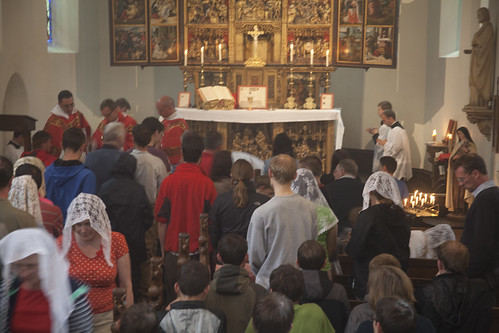 |
| Pilgrims on their way to Walsingham with the LMS Pilgrimage, at Oxburgh Hall chapel |
The issue of ladies wearing head coverings in church is one of those things which a lot of people, no doubt, expected simply to go away, if it hasn't already. It hasn't, and it isn't. There is a growing revolt by young Catholic women against the attitude that wearing a mantilla in church is freakish. This of course has commercial implications, and I've noticed that it is increasingly easy to buy them. You can, for example, get them in the CTS bookshop outside Westminster Cathedral, and online from Cenacle Books. Cenacle Books right now offers a choice of a dozen. We've come a very long way in the last ten years or so.
I've written about the rationale for mantillas here, and about the question of whether the custom would best be, in the long term, obligatory or just voluntary, here. The latter post has a rather amusing video by a young lady about the importance of mantillas.
I've written about the vitriolic opposition to mantillas by some older women here.
There's a whole blog dedicated to mantillas here - 'Loving Mantillas'.
There's a very interesting article about them here, again by a young Catholic woman. She makes the point that they can be an aid to prayer for the person wearing them, as well as helping to avoid distracting others.
Cardinal Burke makes the point that ladies covering their heads is still 'expected' in the Extraordinary Form.
There's an interesting argument, referring to treatments by a couple of neo-conservatives and lots of authoritative sources, here, that the lifting of the canonical obligation for women to cover their heads in church in the 1983 Code of Canon Law has left intact the custom, which has its own normative force. Unless the Church declares that the custom is abrogated, women are, therefore, still obliged to wear mantillas (or something else). Obviously, this argument applies just as much to the Novus Ordo.
Something else which is perhaps worth saying is that the custom was the women wore mantillas (or something) when men took off their hats. (This means 'in church', not just 'during Mass'.) One of the side-issues of the question is that the decline of hat-wearing by both sexes has made the parallel between the obligation on each sex less clear. Men don't have to take off their hats because, generally speaking, they aren't wearing them in the first place. Women can't just keep them on, for the same reason.
Here's the informative discussion on Fish Eaters.
As a matter of interest, since the English translation of the 1917 Code is not online, this is what that code's canon 1262 had to say.
1. It is desirable that, consistent with ancient discipline, women be separated from men in church.
2. Men, in a church or outside a church, while there are assisting at sacred rites, shall be bare-headed, unless the approved mores of the people or peculiar circumstances of things determine otherwise; women, however, shall have a covered head and be modestly dressed, especially when they approach the table of the Lord.
I have seen men and women sit on different sides of a church, in Tanzania. I get the impression that this hasn't been widely done in Europe for a long time, but I may be wrong.
Theee are lots of personal testimonies from women about why they like mantillas; here's new one: http://www.firstthings.com/web-exclusives/2015/02/why-i-wear-the-mantilla
Knights and Dames sit on separate sides of church at Masses for the Equestrian Order of the Holy Sepulchre of Jerusalem, the Dames wearing mantillas.
ReplyDeleteThe tradition of separate seating was revived in the Church of England at All Saints Margaret Street London W1 during the Second World War (when the incumbent was a Benedictine monk of Nashdom Abbey) and may well still survive at Staunton Harold in Leicestershire, where it was certainly still maintained in the 1990s.
ReplyDeleteSt Paul says that women who dishonour their heads by not covering them ought to be shaven...
ReplyDeleteLadies and girls who wear a mantilla or hat are a great witness to Tradition and Sacred Scripture. It is also a strong witness to our faith to see a large traditional Catholic family in church with all the girls wearing a head covering and praying devoutly together.
ReplyDeleteThe separation of the sexes in church is still seen in the placement of the statues of the saints: women on the left side (gospel side) and men on the right side (epistle side). In most churches, for example, the Lady altar is on the left side, while the St. Joseph altar is on the right side.
ReplyDeleteIn the Netherlands, in some old churches, the pews are different: on the men's side, there is sometimes some sort of shelve or hook to store your hat, while on the women's side, no such provisions are taken.
Thank you! That is extremely interesting. Clearly this was still going on into the 20th century.
Delete